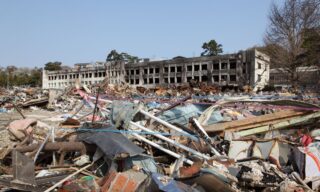Your donation will help us produce journalism like this. Please give today.

North Hollywood High School is a construction zone.
On any day at the North Hollywood campus, workers at the center of the historic high school campus are busy erecting an auditorium, or gutting the school’s outdated pipes.
Kids and teachers pick their way past the ongoing work, oblivious to the chatter of construction workers who are ensuring their safety for when the ‘big one’ loosens from the nearby San Andreas fault and shakes California.
The $315 million renovation at North Hollywood High is part of an ongoing effort by the Los Angeles Unified School District to harden school buildings against earthquakes that’s getting a fresh kickstart after a $9 billion school bond was approved by voters last month.
A state law compels LA Unified to evaluate schools for earthquake safety and make upgrades when needed. The district has completed evaluations at more than 200 schools considered at risk in case of earthquakes and needs to evaluate more than 400 more.
The district has already completed earthquake fixes as less than 40 schools. Others, like North Hollywood High School, are ongoing.
“At the end of this project, this school is going to be totally transformed,” said Julio Palacio, LAUSD’s north regional manager of asset management of the work at North Hollywood High.
LAUSD schools held up safely when a moderately sized earthquake shook the region on the first day of class this year.
But when it comes to earthquakes, the Golden State has a track record of taking preventative measures only after disaster strikes.
In 1933, a Long Beach earthquake that killed over 100 people led to the establishment of the Field Act, which mandated new earthquake safety rules for all public school buildings.
When the Northridge earthquake shook Los Angeles again 60 years later, $700 million in damages to 835 LAUSD buildings exposed the state’s failure to ensure that all public school buildings met those building codes.
In response, state lawmakers in 1999 passed AB300, the law that requires the district to evaluate schools for earthquake safety and address shortcomings with retrofits to buildings.
LAUSD has identified 667 of its school buildings that need to be evaluated for earthquake safety under the law because they are considered at risk due to age or construction.
So far the district has only retrofitted 34 buildings.
Disaster hasn’t struck again, and officials insist the district isn’t waiting. But, their work is slow-going due to limited funding and staggered construction schedules that keep the school doors open for the kids while the work gets done.
Scott Singletary, the interim deputy director of the asset management department at LAUSD, said that due to limited funding, the district is prioritizing rebuilding and retrofitting the most vulnerable schools.
When the North Hollywood High School project is complete in 2026, the school will have a new, earthquake-safe auditorium, retrofitted historical buildings and other expanded, safer facilities.
The district hopes to finish work at the other schools a few years later.
“By 2030…a lot of the work that we have in play will be finishing up, and with new funding…new money we will be systematically starting other projects,” Singletary said. “We hope to keep it rolling so that every year we see more buildings being addressed and come online, and students having the benefit of safe, modern buildings.”
Singletary was referring to the $9 billion school construction bond voters approved in November. The district claims that this money will only account for 11% of the funding that they need to upgrade all of their schools.
Joe Demers, a civil engineer for Alpha Structural, a building repair company, thinks LAUSD buildings are currently safe.
Demers retrofits smaller buildings like single-family homes across Los Angeles County. When the city shakes, calls pour into Alpha Structural as people are reminded of the unstable ground that the city is built on. Demers thinks the work is important to guard against future earthquakes.
“Overall, I’m confident with myself or my kids being in any building that exists now,” Demers said. “The danger is relatively low for any individual person, but the work still needs to get done to make sure everyone stays safe.”
This article is part of a collaboration between The 74 and the USC Annenberg School for Communication and Journalism.